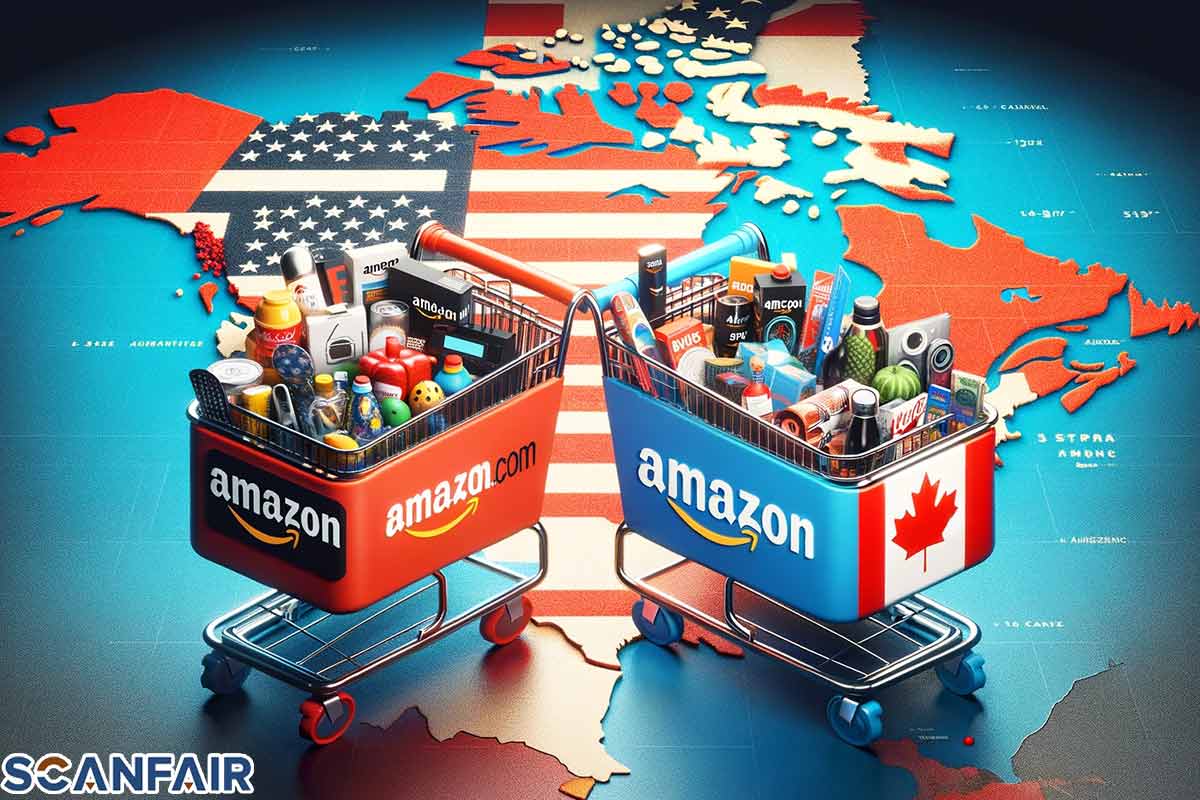In the ever-evolving online retail landscape, Amazon stands as a colossus, with its regional variants like Amazon.com and Amazon.ca catering to diverse markets with tailored offerings. Amazon.com, the flagship platform launched in 1994, revolutionized the e-commerce space, setting the standard for online shopping with its vast product range, customer-centric approach, and innovative technologies. Meanwhile, Amazon.ca, introduced to the Canadian market in 2002, adapted the successful formula to meet Canadian consumers’ unique needs and preferences. This introduction compares these two behemoths, shedding light on how they cater to their respective audiences through differences in product availability, pricing strategies, shipping options, and localized content, aiming to comprehensively understand their roles in the global and Canadian retail landscapes. In the essay, we at Scan Fair will talk more about this topic.
History and Expansion
Amazon.com, founded by Jeff Bezos in 1994, began as an online bookstore and quickly expanded its catalog to include a vast array of products, becoming the world’s largest online retailer. Its growth has been marked by innovation, including introducing Amazon Prime and AWS and pioneering cloud computing and smart home products. Amazon.ca was launched in 2002, extending Amazon’s footprint into Canada. Initially focusing on books, music, and DVDs, it expanded to include electronics, home goods, and a wide variety of other products, mirroring the evolution of its American counterpart but tailored for the Canadian market.
Expansion Into Canadian and American markets
Amazon.com’s expansion into the American market set the stage for its global dominance, leveraging vast logistics networks and data-driven customer insights to offer unmatched convenience and competitive prices. Following its successful model, Amazon.ca has similarly grown to dominate Canadian online retail. It adapted to local nuances such as bilingual listings and tailored its offerings to Canadian preferences and holidays. Both platforms have continually evolved, introducing localized features and services like Amazon Prime Canada, which offers benefits suited to the Canadian context, such as faster shipping within Canada and access to Canadian content on Prime Video.
Product Range and Availability
Amazon.com and Amazon.ca offer various products, spanning categories from electronics to home essentials, books, and beyond. However, the depth and breadth of the product range can vary significantly between the two. Amazon.com, serving a more extensive and diverse market, often boasts a broader selection, especially in niche categories or for the latest tech gadgets. In contrast, Amazon.ca, while comprehensive, Amazon.ca may have a slightly more curated selection, focusing on products that are more relevant to Canadian consumers, including those that comply with local regulations and preferences.
Exclusive products on Each platform
Both platforms feature exclusive products catering to their respective audiences’ unique tastes and needs. For instance, Amazon.com may offer products from U.S.-based startups through programs like Amazon Launchpad and items that are popular in the U.S. market. Conversely, Amazon.ca often includes products from Canadian companies, local artisan goods, and items specifically designed for the Canadian climate and lifestyle. This localization effort ensures that while there is a vast overlap in product offerings, each platform maintains a distinct identity with exclusives that resonate with its target demographic.
Pricing and Currency
The comparison of prices between Amazon.com and Amazon.ca reveals variances that are not solely based on the currency value. While the introductory conversion rate between USD and CAD would suggest a straightforward comparison, prices on Amazon.ca often appear higher. This discrepancy can be attributed to several factors, including import duties, taxes, and higher shipping and handling costs associated with bringing products into Canada. Additionally, market demand and the presence of local suppliers also play significant roles in determining final product prices on each platform.
Impact of Currency Exchange Rates on Pricing
Currency exchange rates considerably influence pricing differences between Amazon.com and Amazon.ca. The USD/CAD exchange rate fluctuations can lead to dynamic price adjustments on the Canadian site. For consumers, this means that the cost of the same item may vary daily when converted to a common currency. It’s also essential for Canadian shoppers to consider the exchange rate when making cross-border purchases from Amazon.com, as the final amount charged in CAD may be higher than the listed price in USD after accounting for conversion fees charged by credit card companies or banks.
Shipping and Delivery
Shipping fees and delivery times between Amazon.com and Amazon.ca often reflect the logistical challenges of each country’s geography and infrastructure. Amazon.com typically offers a range of shipping options in the U.S., including same-day or two-day delivery for Prime members, at competitive rates. In contrast, Amazon.ca may have slightly higher shipping fees and longer delivery times, particularly for remote or rural areas in Canada. However, Amazon.ca has made strides in improving delivery efficiency and offering free shipping thresholds to enhance customer satisfaction.
International Shipping Options and Restrictions
International shipping from Amazon.com to Canada and vice versa is subject to a complex web of regulations, customs duties, and taxes. While Amazon.com offers international shipping to Canada for many of its products, shoppers may face additional fees or restrictions on certain items due to Canadian import laws. Conversely, Amazon.ca’s international shipping options are more limited, focusing on serving the Canadian market. Customers looking to ship products across borders should know these potential hurdles and costs associated with international orders.
Customer Experience
The user interfaces of Amazon.com and Amazon.ca are designed with a clear, intuitive layout, maintaining a consistent brand image across both platforms. However, subtle differences in navigation and localization cater to their respective audiences’ specific preferences and needs. Amazon.com often integrates more aggressive marketing of its wide range of products and services, including streaming and cloud computing, whereas Amazon.ca focuses on a more streamlined approach, emphasizing product categories more relevant to Canadian consumers, such as winter gear and localized content.
Mobile app Usability and Features
The Amazon mobile app, available for Amazon.com and Amazon.ca users, offers a seamless shopping experience with features tailored to each market. Both app versions provide easy access to account settings, order history, and a vast selection of products. However, the Amazon.ca app might offer unique functionalities suited to Canadian users, like bilingual support (English and French) and localized deals. Push notifications for upcoming sales and delivery updates are standard across both apps, ensuring users stay informed regardless of location.
Sales and Promotions
Amazon.com and Amazon.ca host several major sales events annually, aligning with global retail trends to offer deep discounts and promotions. Prime Day, an exclusive event for Amazon Prime members, features both platforms with significant markdowns across various categories. Black Friday and Cyber Monday are other vital highlights, bringing many deals to kickstart the holiday shopping season. While the timing and frequency of these sales events are similar across Amazon.com and Amazon.ca, the specific deals and promotions can vary, reflecting American and Canadian consumers’ different preferences and shopping behaviors.
Exclusive Deals for Canadian and American Customers
Exclusive deals tailored to each audience can be found on Amazon.com and Amazon.ca. For instance, Amazon.com might offer steep discounts on tech gadgets and electronics popular in the U.S. market. At the same time, Amazon.ca could focus on deals that appeal to Canadian lifestyles, such as outdoor gear for camping and winter sports. Seasonal promotions also reflect regional holidays and events, with Amazon.ca offering specials for Canada Day and Amazon.com capitalizing on U.S. holidays like Independence Day. These exclusive deals ensure that each platform caters effectively to its respective consumer base, enhancing the shopping experience with relevant bargains.
Amazon Prime Benefits
Amazon Prime offers a suite of benefits in Canada and the USA, including free two-day shipping, streaming of movies and T.V. shows through Prime Video and exclusive access to deals on Prime Day. However, the USA version often includes additional perks such as access to a broader range of streaming content, more extensive music streaming options, and additional services like Amazon Fresh and Amazon Pharmacy. In contrast, Amazon Prime in Canada focuses on core benefits, adapting its offerings to the Canadian market with features like free same-day delivery in some metropolitan regions and access to Canadian content on Prime Video.
Cost-effectiveness of Amazon Prime in Both Regions
Evaluating the cost-effectiveness of Amazon Prime in Canada versus the USA involves considering the subscription costs relative to the benefits offered. The broader range of perks in the USA can justify the subscription price for users who take full advantage of the services provided. In Canada, despite a slightly narrower scope of services, the cost of Amazon Prime remains competitive, particularly for customers in urban areas who benefit from rapid shipping times. Both regions find value in the membership through different avenues, reflecting Amazon’s tailored approach to cater to each market’s needs and preferences.
Marketplace and Third-Party Sellers
The Amazon Marketplace is a dynamic component of both Amazon.com and Amazon.ca, hosting a multitude of third-party sellers. The American site, Amazon.com, boasts a more extensive and diverse seller ecosystem, reflecting the vast U.S. market and its global reach. This diversity enables a broader array of products, including unique and hard-to-find items. Amazon.ca, while smaller, has seen significant growth, offering Canadian consumers increased access to local and international sellers. The platform’s adaptation to Canadian regulations and bilingual requirements showcases its commitment to providing a tailored and comprehensive shopping experience.
Impact on Product Variety and Price Competition
Third-party sellers on Amazon.com and Amazon.ca greatly enhance product variety, giving customers access to a broader range of goods than what Amazon directly stocks. This influx of options fosters competitive pricing as sellers vie buyers’ attention through competitive pricing strategies and unique product offerings. The result is a dynamic marketplace where consumers can find everything from mainstream products to niche items at competitive prices, benefiting from the competitive landscape that third-party sellers create.
Return Policies and Customer Support
Amazon.com and Amazon.ca prioritize customer satisfaction, offering generous return policies allowing customers to return products within a specified period. However, the specifics of these policies, including the return window and conditions for acceptance, may vary slightly between the two platforms. Amazon.com often has a broader return window due to its more extensive logistics network, facilitating quicker returns processing. While somewhat more constrained by geographical challenges, Amazon.ca offers competitive return policies, ensuring customers can shop confidently.
Effectiveness of Customer Support Channels
Amazon.com and Amazon.ca invest heavily in customer support, providing multiple channels for assistance, including phone, email, and live chat. These support channels are highly effective on both platforms, with dedicated teams to promptly address customer queries and issues. However, the range of support options and availability hours may vary, reflecting each country’s operational hours and customer service practices. Despite these differences, the commitment to resolving customer concerns efficiently and effectively remains a central focus for Amazon, regardless of the region.
Localization and Cultural Relevance
Amazon.com and Amazon.ca adeptly cater to their local audiences by tailoring website interfaces, product offerings, and marketing strategies to reflect regional preferences and cultural nuances. Amazon.com addresses the vast and diverse American market with various products and services that appeal to a broad spectrum of cultural backgrounds. Amazon.ca, on the other hand, Amazon.ca focuses on products and content that resonate with Canadian values, including bilingual site options in English and French and merchandise that aligns with Canadian lifestyles and interests.
Examples of Region-Specific Content and Products
Region-specific content and products on Amazon.ca include items like Canadian literature, maple syrup, and hockey equipment aimed at celebrating Canadian culture and interests. Amazon.com offers an expansive selection of products tailored to U.S. holidays like Thanksgiving and the 4th of July, along with a wide variety of American sports gear and regional foods. These carefully curated selections ensure that each platform remains relevant and appealing to its respective audience, fostering a sense of community and cultural connection among its users.
Payment Options and Security
Amazon.com and Amazon.ca offer a variety of payment methods to accommodate their broad customer base, including major credit cards, debit cards, Amazon gift cards, and, in some cases, direct bank payments. Amazon.com additionally supports payment through Amazon Pay, allowing users to use the payment methods stored in their Amazon account for purchases on third-party websites. While both platforms strive to provide flexible payment solutions, Amazon.ca is specifically tailored to include options preferred by Canadian consumers, such as Interac, in some instances.
Security Measures for Online Transactions
Amazon.com and Amazon.ca employ robust security measures to protect customers during online transactions. These measures include secure socket layer (SSL) encryption, two-factor authentication for account access, and continuous monitoring for fraudulent activity. Amazon’s A-to-Z Guarantee further protects buyers by ensuring the condition and timely delivery of purchases. The commitment to security is paramount, providing that customers can shop confidently, knowing their personal and payment information is safeguarded against unauthorized access.
Environmental and Social Initiatives
Amazon.com and Amazon.ca are actively involved in sustainability practices and community engagement, aiming to reduce their environmental footprint and contribute positively to society. Initiatives include investing in renewable energy projects, reducing packaging waste through the Frustration-Free Packaging program, and engaging in local community projects. These efforts are part of Amazon’s global commitment to building a sustainable business for customers and the planet.
Comparison of Corporate Responsibility Efforts
While Amazon.com and Amazon.ca share the overarching goals of Amazon’s global sustainability and social responsibility initiatives, specific programs may vary by region to address local environmental concerns and community needs. For instance, Amazon.ca might focus on initiatives that support Canadian ecological preservation and social welfare projects, aligning with national priorities and values. Both platforms contribute to Amazon’s Climate Pledge to become net-zero carbon by 2040, demonstrating a unified but locally nuanced approach to corporate responsibility.
Future Outlook and Innovations
Amazon is constantly innovating, and future features for Amazon.com and Amazon.ca are expected to focus on enhancing customer experience through technology. In the USA, anticipations point towards more advanced AI-driven recommendations, augmented reality (A.R.) shopping experiences, and expanded drone delivery services. For Canada, improvements in cross-border shipping efficiency, enhanced localization of services, and broader access to Amazon’s technology ecosystem are on the horizon.
Predictions for the Evolution of Online Shopping
The evolution of online shopping will likely emphasize personalization, speed, and sustainability. Predictions include integrating more personalized shopping experiences using A.I., faster delivery options through logistical innovations, and increased focus on eco-friendly practices. Amazon.com and Amazon.ca will play pivotal roles in shaping these trends, leveraging technology to meet consumer demands for convenience and addressing the growing call for responsible corporate behavior.
Conclusion
The comparison between Amazon.com and Amazon.ca illuminates the nuanced yet significant differences that cater to their respective markets. Both platforms demonstrate Amazon’s adaptability and commitment to serving diverse consumer needs, from product assortments, pricing, and shipping options to customer service and sustainability efforts. As e-commerce continues to evolve, Amazon’s innovations and localized strategies will likely further enhance shopping experiences, ensuring that regardless of whether customers are in Canada or the USA, they can access a seamless, efficient, and tailored online shopping journey.




